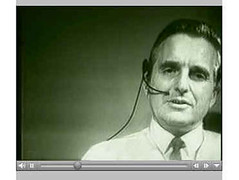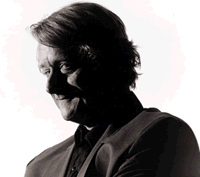
Douglas Engelbart has always been ahead of his time, having ideas that seemed far-fetched at the time but later were taken for granted. For instance, as far back as the 1960s he was touting the use of computers for online conferencing and collaboration. Engelbart's most famous invention is the computer mouse, also developed in the 1960s, but not used commercially until the 1980s. Engelbart wanted to use technology to augment human intellect. He saw technology, especially computers, as the answers to the problem of dealing with the ever more complex modern world and has dedicated his life to the pursuit of developing technology to augment human intellect. Douglas Engelbart was born in 1925, in Oregon, where he grew up on a small farm. In 1942, he graduated high school and went to Oregon State University to study electrical engineering. His studies were interrupted by WWII. He joined the Navy and spent two years in the Philippines as a radar technician. While stationed in the Philippines he read Vannevar Bush's "As We may Think." Engelbart would later write to Bush acknowledging the influence Bush's article had had on his own work.
In 1968, at the Fall Joint Computer Conference in San Francisco, Engelbart demonstrated NLS in a 90 minute multimedia presentation that included a live video conference with staff members back in his lab 30 miles away. To this day, Engelbart's demo is still known as "the mother of all demos. Engelbart has continued to work on augmenting human intellect, seldom receiving the acknowledgement many believe he deserves. In 1989, he founded the Bootstrap Institute to foster high performance organizations by developing enabling technologies and promoting collaboration.

Ted Nelson is a somewhat controversial figure in the computing world. For thirty-something years he has been having grand ideas but has never seen them through to completed projects. His biggest project, Xanadu, was to be a world-wide electronic publishing system that would have created a sort universal libary for the people.He is known for coining the term "hypertext." He is also seen as something of a radical figure, opposing authority and tradition. He has been called "one of the most influential contrarians in the history of the information age. He often repeats his four maxims by which he leads his life: "most people are fools, most authority is malignant, God does not exist, and everything is wrong."
Nelson was raised by his grandparents in Greenwich Village, New York. His father is a movie director and his mother an actor. He had little contact with his father and almost none with his mother. He was lonely as a child and had problems caused by his Attention Deficit Disorder (ADD). Nelson attended Swarthmore college where he earned a BA in philosophy. In 1960, he enrolled in graduate school at Harvard. During his first year he attempted a term project creating a writing system similar to a word processor, but that would allow different versions and documents to be linked together nonlinearly, by association. This was, in part, an attempt to keep track of his own sometimes frantic associations and daydreamings brought about by his ADD.

XANADU
Nelson continued to expound his ideas, but he did not possess the technical knowledge to tell others how his ideas could be implemented, and so many people simply ignored him (and have ever since). Still, Nelson persisted. In 1967, he named his system XANADU, and with the help of interested, mainly younger, computer hacks continued to develop it.
Xanadu was concieved as a tool to preserve and increase humanity's literature and art. Xanadu would consist of a world-wide network that would allow information to be stored not as separate files but as connected literature. Documents would remain accessible indefinitely. Users could create virtual copies of any document. Instead of having copyrighted materials, the owners of the documents would be automatically paid via electronic means a micropayment for the virtual copying of their documents.
Xanadu has never been totally completed and is far from being implemented. In many ways Tim Berners-Lee's World Wide Web is a similar, though much less grand, system. In 1999, the Xanadu code was made open source.
No comments:
Post a Comment